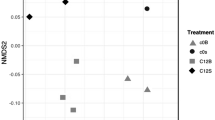Abstract
Bacillus subtilis B579, which was isolated from rhizosphere of cucumber, exhibited an excellent biocontrol activity on soil-born pathogens under greenhouse conditions. It could colonize in rhizosphere of cucumber with large number of populations after inoculated in plant growth season. To reveal the effect of high level colonization of B. subtilis B579 on rhizobacteria community structure, cultivation-based analysis coupled with denaturing gradient gel electrophoresis (DGGE) analysis were used to profile the changes of rhizobacteria community structure sampling at 1 week interval. Cultivation-based and DGGE fingerprinting analysis showed significant plant-dependent and seasonal shifts in rhizobacteria populations. Only minimal and transient effects were observed at 4–9 weeks after sowing in samples of B579 treatment, without the pathogen inoculation and showed the best plant growth potential. Sequencing of dominant bands excised from the gel revealed that Streptomyces sp. was the dominate species in soils before and after sowing. Burkholderia sp. was the dominate species in bulk soil, while Bacillus sp. was dominated in rhizosphere within the growth season. Arthrobacter ramosus and Nocardioides sp. were identified as the specific species in samples treated by B579 at the maturity and flowering stages of cucumber.



Similar content being viewed by others
References
Amann RI, Ludwig W, Schleifer KH (1995) Phylogenetic identification and in situ detection of individual microbial cells without cultivation. Microbiol Rev 59:143–169
Bais HP, Weir TL, Perry LG, Gilroy S, Vivanco JM (2006) The role of root exudates in rhizosphere interactions with plants and other organisms. Ann Rev Plant Biol 57:233–266
Bankhead SB, Landa BB, Lutton E, Weller DM, Gardener B, McSpadden GBB (2004) Minimal changes in rhizobacterial population structure following root colonization by wild type and transgenic biocontrol strains. FEMS Microbiol Ecol 49:307–318
Berg G (2009) Plant-microbe interactions promoting plant growth and health: perspectives for controlled use of microorganisms in agriculture. Appl Microbiol Biotechnol 84:11–18
Buée M, De Boer W, Martin F, van Overbeek L, Jurkevitch E (2009) The rhizosphere zoo: an overview of plant-associated communities of microorganisms, including phages, bacteria, archaea, and fungi, and of some of their structuring factors. Plant Soil 321:189–212
Chen F, Wang M, Zheng Y, Luo JM, Yang XR, Wang XL (2010) Quantitative changes of plant defense enzymes and phytohormone in biocontrol of cucumber Fusarium wilt by Bacillus subtilis B579. World J Microbiol Biotechnol 26:675–684
Chong CW, Tan GYA, Wong RCS, Riddle MJ, Tan IKP (2009) DGGE fingerprinting of bacteria in soils from eight ecologically different sites around Casey Station, Antarctica. Polar Biol 32:853–860
Germida JJ, Siciliano SD, de Freitas JR, Seib AM (1998) Diversity of root-associated bacteria associated with field-grown canola (Brassica napus L.) and wheat (Triticum aestivum L.). FEMS Microbiol Ecol 26:43–50
Gunnell D, Eddleston M, Phillips MR, Konradsen F (2007) The global distribution of fatal pesticide self-poisoning: systematic review. BMC Public Health 7:357
Ibekwe AM, Grieve CM (2004) Changes in developing plant microbial community structure as affected by contaminated water. FEMS Microbiol Ecol 48:239–248
Johri BN, Sharma A, Virdi JS (2003) Rhizobacterial diversity in India and its influence on soil and plant health. Adv Biochem Eng Biotechnol 84:49–89
Kim TW, Lee JH, Park MH, Kim HY (2010) Analysis of bacterial and fungal communities in Japanese and Chinese-fermented soybean pastes using nested PCR–DGGE. Curr Microbiol 60:315–320
Leach AW, Mumford JD (2008) Pesticide environmental accounting: a method for assessing the external costs of individual pesticide applications. Environ Pollut 151:139–147
Li ZG, Fu XH, Deng W, Yang YW, Cui YS, Zhao P (2009) Analysis of bacterial diversity during the processing of Brassica juncea coss var. tsatsai by the culture-independent and denaturing gradient gel electrophoresis (DGGE) methods. Microbiology 36:371–376
Mahaffee WF, Kloepper JW (1997) Temporal changes in the bacterial communities of soil, rhizosphere, and endorhiza associated with field-grown cucumber (Cucumis sativus L.). Microb Ecol 34:210–223
Mao W, Lewis JA, Hebbar PK, Lumsden RD (1997) Seed treatment with a fungal or a bacterial antagonist for reducing corn damping-off caused by species of Pythium and Fusarium. Plant Dis 81:450–454
Semenov AM, Van Bruggen AHC, Zelenev VV (1999) Moving waves of bacterial populations and total organic carbon along roots of wheat. Microb Ecol 37:116–128
Thakore Y (2006) The biopesticide market for global agricultural use. Ind Biotechnol 2:194–208
Vainio EJ, Hantula J (2000) Direct analysis of wood-inhabiting fungi using denaturing gradient gel electrophoresis of amplified ribosomal DNA. Mycol Res 104:927–936
Winding A, Binnerup SJ, Pritchard H (2004) Non-target effects of bacterial biological control agents suppressing root pathogenic fungi. FEMS Microbiol Ecol 47:129–141
Acknowledgments
This work was supported by the Natural Science Foundation of Tianjin, China (Project No. 09JCZDJC19100), and Scientific Research foundation for Doctor, Liaocheng University, China (Project No. 3010).
Author information
Authors and Affiliations
Corresponding authors
Rights and permissions
About this article
Cite this article
Chen, F., Wang, M., Zheng, Y. et al. The Effect of Biocontrol Bacteria on Rhizosphere Bacterial Communities Analyzed by Plating and PCR-DGGE. Curr Microbiol 67, 177–182 (2013). https://doi.org/10.1007/s00284-013-0347-0
Received:
Accepted:
Published:
Issue Date:
DOI: https://doi.org/10.1007/s00284-013-0347-0




